ASUS F1A75-I Deluxe Review – Llano and Mini-ITX
by Ian Cutress on October 1, 2011 5:30 PM EST- Posted in
- Motherboards
- Asus
- A75
LAN Speed Test
LAN Speed Test is a freeware program designed for testing the network connection between two PCs on a home network. The speed of the transfer is limited by the lowest common denominator on the network, so if you have gigabit Ethernet capable computers but a 100 Mbit capable router, you are limited to 100 Mbit transfer. Note that this is really a formality – if a network port is rated at 1 Gbps, then chances are that it will hit at least 90+% of this value. For this test, we use LAN Speed Test to transfer a 1000 MB file across a home network with a 1 Gbps lowest common speed to the same machine each time, in a read/write scenario.
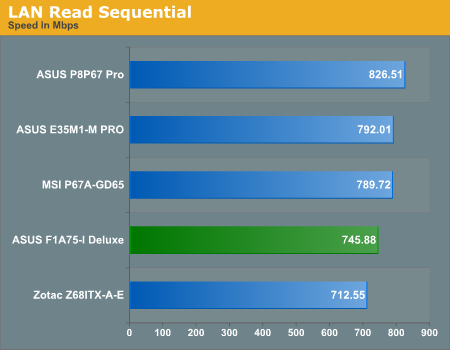
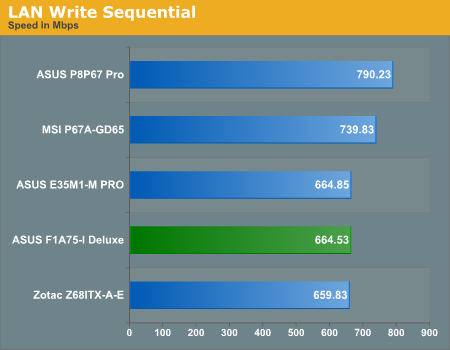
USB Speed
For this benchmark, we run CrystalDiskMark to determine the ideal sequential read and write speeds for the USB port using our 64GB Patriot SuperSpeed USB 3.0 drive. Then we transfer a set size of files from the SSD to the USB drive, and monitor the time taken to transfer. The files transferred are a 1.52 GB set of 2867 files across 320 folders – 95% of these files are small typical website files, and the rest (90% of the size) are the videos used in the Sorenson Squeeze test.
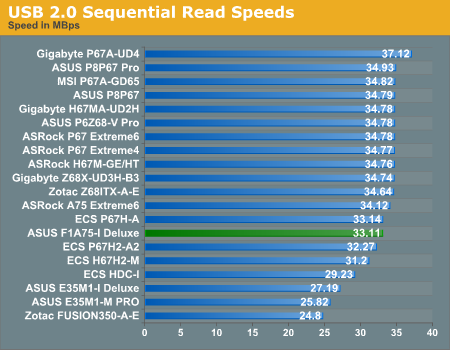
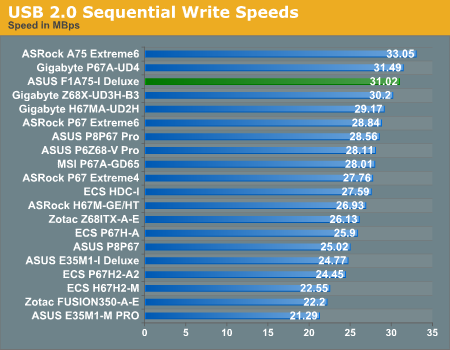
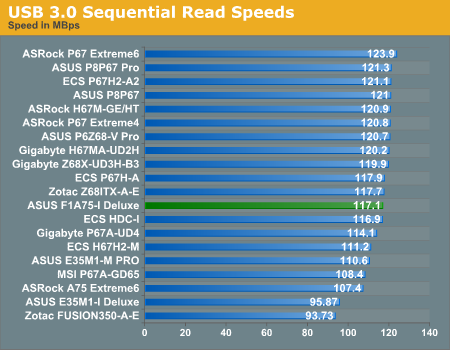
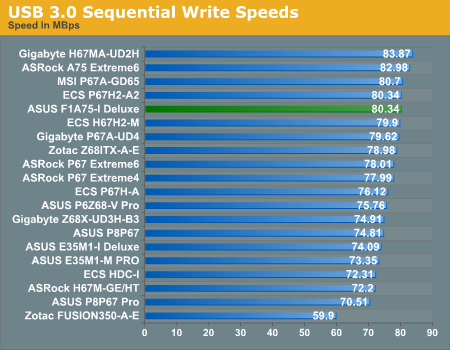

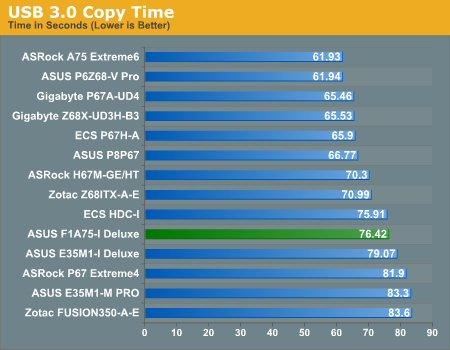
The F1A75-I Deluxe stands out in the USB 2.0 sequential writing performance test, but nothing particularly stands out in the other results.
SATA Testing
We also use CrystalDiskMark for SATA port testing. The operating system is installed on the Micron RealSSD C300, which is rated at 355 MB/s read and 215 MB/s write, and the sequential test is run at the 5 x 1000 MB level. This test probes the efficiency of the data delivery system between the chipset and the drive, or in the case of additional SATA ports provided by a third party controller, the efficiency between the controller, the chipset and the drive.
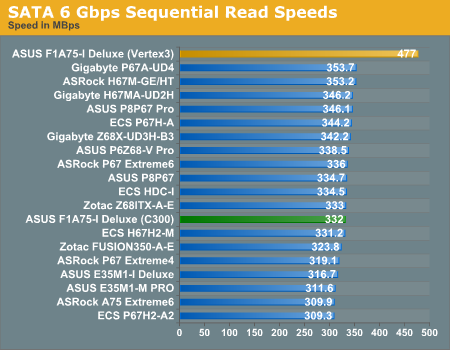

The SATA ports perform relatively standard in our sequential testing.
DPC Latency
Deferred Procedure Call latency is a way in which Windows handles interrupt servicing. In order to wait for a processor to acknowledge the request, the system will queue all interrupt requests by priority. Critical interrupts will be handled as soon as possible, whereas lesser priority requests, such as audio, will be further down the line. So if the audio device requires data, it will have to wait until the request is processed before the buffer is filled. If the device drivers of higher priority components in a system are poorly implemented, this can cause delays in request scheduling and process time, resulting in an empty audio buffer – this leads to characteristic audible pauses, pops and clicks. Having a bigger buffer and correctly implemented system drivers obviously helps in this regard. The DPC latency checker measures how much time is processing DPCs from driver invocation – the lower the value will result in better audio transfer at smaller buffer sizes. Results are measured in microseconds and taken as the peak latency while cycling through a series of short HD videos - less than 500 microseconds usually gets the green light, but the lower the better.
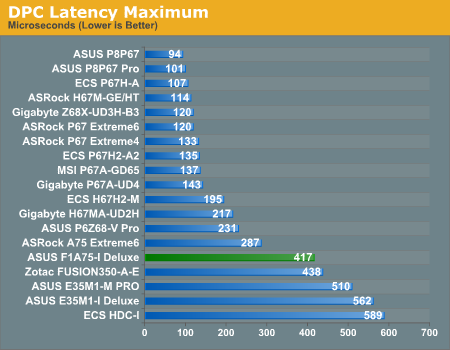
My initial findings gave a DPC Latency reading around 1000 microseconds, and would randomly jump to 3000 microseconds. Eventually I was able to track down my source of the issue - the ASUS AI Suite II software, which automatically starts up on boot when installed. When this software is turned off, my DPC latency would reduce to a sub 500 microsecond level. Note, many users wont actually notice a 3000 microsecond latency - after speaking with ASUS, they seem to have had some issues replicating this issue. However, there is a quick fix if it is an issue for any user. I would also like to note that this issue may be fixed in later BIOS versions when the board comes to market.










51 Comments
View All Comments
mariush - Sunday, October 2, 2011 - link
Well, see, here's where you're wrong and that's why it would have been nice to test that.This hardware was using 122 watts WITH an additional video card, on a 1000 watts power supply that has 80.8% efficiency at such low loads.
So realistically, the system uses about 110 real watts on full load WITH the additional video card.
I would have liked to know how much is the system actually using WITHOUT an extra video card - my guess is the consumption would drop by about 30 watts in load and about 10-15 watts in idle.
An 120 watt pico PSU has about 87% efficiency and can only deliver about 6-8 Amps on 12v line, when powered from a 19v laptop adapter (it's irrelevant how efficient this adapter is for this talk).
So assuming the pico psu can do a maximum of 6A on 12v (72w), it really makes a difference if the consumption drops to about 85-90 watts in total without an additional video card (because memory/ uses the 3.3v lines and 5v is used by the USB port/lan/wireless and the SSD, so the rest would probably fit in those 6 Amps of 12v power)
As for the ripple paragraph, both the laptop adapter AND the pico psu power converter do filtering so they're quite good and provite quality power to the system, see : jonnyguru.com/modules.php?name=NDReviews&op=Story5&reid=207
As things are now, as the tests were made with 1000w psu and only with an extra video card (would you like future systems to only be tested in Crossfire or SLI?) ... there's really no way to form an opinion.
And as for the middle paragraph...I own a Seasonic X-650, which according to tests can manage up to 92.5% efficiency. The results would have been much closer to the reality and the tests could still be done on other systems even with two power hungry video cards
mariush - Sunday, October 2, 2011 - link
Oh... and a last thing...The system was tested with the Corsair water cooler - the pump itself uses 2-3 watts of power and you also need a fan to cool the radiator, which is at least another 2 watts...
The stock cooler for the processor probably uses less than 3 watts at full speed.
I know, it's very little but it adds up, and the majority of the people buying these things won't buy water coolers for them and 1000w power supplies.
pinto76 - Monday, October 3, 2011 - link
The whole review is subpar. Aside from the language I'm sure all of 3 people reading cared for water cooling comments or the above mentioned power consumption figures off a 1000w PSU. There's no word about wifi. Not what it is or whether it even works at all. For the future, guys, please, boot up from an Ubuntu live CD, type 'sudo iw list', 'sudo lshw -C network -sanitize', and 'sudo lspci -v' and save outputs as an attachment to the article. Trust me it'll be far better help to at least half the people reading the articles and actually thinking of buying this stuff.And you do have to get on their butts about not providing a vertical mini PCIe slot, it costs them more to do it because they have to make a bracket since mini PCIe cards won't stay up by themselves; in the low profile fitting you'll be limited to half size cards only replacements. And you'll want to replace it if what Zotac puts in their boards is any indication - and not that I'm knocking them for it, I'd much rather have mini PCIe with a vertical bracket than anything in the slot anyway.
No word on bluetooth either.
Death666Angel - Saturday, October 1, 2011 - link
However, I think the AsRock A75M-ITX can be more appealing, because of it's different CPU socket position. I have that board because it will fit a Scythe Big Shuriken (awesome low-ish profile cooler) and still have the PCIe slot uncovered (not using it at the moment but it's nice to know I can). Designs such as the Asus here have the problem of having the CPU socket too close to the slot. If you want to use the PCIe slot you either need quite a small cooler (read: loud) or go with a water cooling all-in-one and that brings a whole other pack of problems.Still, it's great to see ITX boards being offered for new systems! The more the better!
just4U - Saturday, October 1, 2011 - link
Considering the features on these baby boards.. I don't quite understand why they command a premium. One would think they'd come in at a lower price point then some of the value MATX boards.DanNeely - Saturday, October 1, 2011 - link
They're more expensive because packing everything in so tightly requires using more compact controller chips for 3rd party features instead of the larger, cheaper versions on full size boards and because squeezing everything together so tightly means having to use more layers in the PCB to connect everything. Packing everything together so tightly makes avoiding EMI problems between components more difficult as well.On top of the engineering challenges miniITX boards are sufficently low volume parts that you start paying penalties in manufacturing costs and have to fund more engineering time per board.
just4U - Saturday, October 1, 2011 - link
I didn't realize the boards had more layers.. when I see these reviews I think of barebone boards like ones made for OEMs and such. Makes some sense I suppose.. Still I think all in all I'd be more likely to pick up a feature rich MATX in the same price range over something like this.. Yeah your casing might be marginally bigger but even so.Death666Angel - Saturday, October 1, 2011 - link
I have a mini ITX case with these measurements:185x240x70 mm
I have barely any space left and right (mini ITX is 170x170mm) and the space that I have in front is used for the built-in PSU dc/dc converter. This case has 3.1l volume. If I were to have the exact same case, just with a mATX mainboard (adding 74mm to the width and depth), I would get:
259x314x70mm, resulting in 5.7l volume, almost doubling it.
That's not something I'd refer to as "marginally bigger".
You really can't compare (m)ATX to ITX in my opinion. :-)
ckryan - Sunday, October 2, 2011 - link
The difference between mini ITX cases and micro ATX cases is substantial. It doesn't take much effort to chop the two inches off of an ATX board to make it micro. Making a micro into a mini is entirely different. Mini ITX boards are 6.7 in x 6.7 in, and most of that gets taken up by the CPU socket/VRM area as well as the DIMM slots. Add in the PCIE slot and you don't have much to work with.Most uATX cases are still 17" deep and 8" wide by at least 13" tall. Many mini ITX enclosures are closer to the size of a Nintendo Wii. Most people don't need such a small system, but if you do it's usually worth the premium. BIOS/UEFI options on a small board are worth their weight in gold, as are competent WiFi options. Under volting is a must have for AMD systems, but 1155 Intel CPUs don't have much to gain from it. With a feature-laden ITX board, a powerful but low tdp processor, and some solid state storage, there's not really many compromises to make. With the right case and mobo you can toss in a powerful GPU, further expanding its range of uses. Or toss in an InfiniTV Quad tuner card and record 4 hd cable streams simultaneously. That's why these boards are great -- there's not much of a limit to the possibilities.
Death666Angel - Saturday, October 1, 2011 - link
First off, the numbers are in favor of ATX and mATX boards, since they just sell more volume. Then, you generally don't have extra stuff like WLAN on most of those standard boards. The layout for the bigger boards is significantly less crowded resulting in easier manufacturing as well.You cannot look at ITX and think "hm, they took an ATX board and just cut stuff off". You have to think "hm, they took an ATX board and just condensed it into this mini board". Offering the same things on less space is generally more expensive. This applies here. The few (RAM, PCI, PCIe) slots you lose unfortunately aren't big money savers ;).